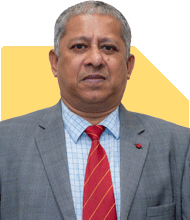Ramalingam Kalirajan |9752 Answers |Ask -Follow
Mutual Funds, Financial Planning Expert - Answered on Jun 04, 2024
He has an MBA in finance from the University of Madras and is a certified financial planner.
He is the director and chief financial planner at Holistic Investment, a Chennai-based firm that offers financial planning and wealth management advice.... more

Sir i am 61 retired. I am single staying with my mother. We don't have health insurance but have 7 crores in fixed deposits and anither 10 crores in nsdl as tax free bonds and equity. Rent we get 38k I am not sure will this be enough due to high inflation which keeps increasing every year. Kindly advice.
Understanding Your Current Financial Situation
Your current assets provide a solid foundation. Fixed deposits offer safety, tax-free bonds provide steady income, and equities ensure growth potential. Your rental income adds a steady cash flow. However, inflation can erode purchasing power over time, making it essential to plan strategically.
Evaluating Your Income Sources
Fixed Deposits: Rs. 7 crores in fixed deposits provide safety and regular interest income. The interest rates on FDs have been relatively low, impacting overall returns.
Tax-Free Bonds and Equity: Rs. 10 crores in tax-free bonds and equity offer a mix of stability and growth. Tax-free bonds provide regular interest without tax implications, while equities offer potential for capital appreciation.
Rental Income: Rs. 38,000 per month adds Rs. 4.56 lakhs annually. This can cover a portion of your living expenses, but may not suffice due to inflation.
Addressing Inflation Concerns
Inflation is a key concern, as it reduces purchasing power. Your portfolio should outpace inflation to maintain your lifestyle. Let's break down strategies to manage and mitigate inflation risk.
Diversifying Your Investments
Balanced Portfolio: Maintain a balanced portfolio with a mix of fixed income, equities, and other investment options. This helps in managing risk and returns.
Equity Exposure: Equities typically outpace inflation over the long term. Maintain a portion of your portfolio in equities to ensure growth.
Debt Instruments: Diversify within debt instruments, including corporate bonds, government securities, and fixed deposits, to manage interest rate risk.
Implementing Systematic Withdrawal Plan (SWP)
SWP Setup: Post-retirement, set up an SWP from your mutual fund investments to ensure regular monthly income.
Capital Preservation: Withdraw a portion of returns, keeping principal invested for ongoing growth.
Health Insurance Planning
Importance of Health Insurance: Health insurance is crucial to protect against high medical expenses. Lack of coverage can lead to financial strain.
Senior Citizen Health Plans: Consider purchasing senior citizen health insurance plans. These offer coverage tailored to older individuals.
Comparative Analysis: Compare different health insurance plans based on coverage, premiums, and claim settlement ratio.
Tax Planning
Tax-Free Bonds: Utilize tax-free bonds to enjoy tax-free interest income, enhancing post-tax returns.
Tax-Efficient Withdrawals: Plan withdrawals from investments to minimize tax liability. Utilize long-term capital gains tax benefits where applicable.
Regular Review: Periodically review tax-saving investments and strategies to optimize tax efficiency.
Estate Planning
Will Creation: Create a will to ensure your assets are distributed according to your wishes. This avoids legal complications.
Nomination Updates: Ensure all investments have updated nominations to facilitate smooth transfer to beneficiaries.
Trust Formation: Consider forming a trust for managing and distributing your assets, especially if you have complex financial arrangements.
Emergency Fund
Adequate Fund: Maintain an emergency fund covering 6-12 months of living expenses. This provides a buffer against unexpected expenses.
Liquid Investments: Keep the emergency fund in liquid investments, such as savings accounts or short-term fixed deposits, for easy access.
Long-Term Care
Long-Term Care Insurance: Explore long-term care insurance options to cover potential future healthcare needs, ensuring peace of mind.
Assisted Living: Consider potential costs of assisted living or home care services as part of long-term planning.
Surrendering Traditional Insurance Policies
Reevaluation: Evaluate traditional insurance policies like LIC, ULIPs, and investment-cum-insurance plans. These often have high costs and lower returns.
Reinvestment: Surrender such policies and reinvest in mutual funds or other higher-yielding investments for better returns.
Professional Guidance
Certified Financial Planner: Engage with a Certified Financial Planner for personalized advice, tailored to your financial goals and risk tolerance.
Periodic Reviews: Conduct periodic reviews with your planner to adjust the strategy based on changing financial needs and market conditions.
Empathy and Understanding
We understand the importance of financial security, especially in retirement. Your disciplined savings and investments reflect a prudent approach. Ensuring ongoing financial stability, managing inflation, and securing healthcare are critical steps.
Compliments on Your Financial Discipline
Your significant savings and investments are commendable. They reflect a strong financial discipline and foresight. Your concern for future financial stability indicates a responsible approach to managing wealth.
Detailed Strategy Analysis
Fixed Deposits: Fixed deposits offer safety but may not keep pace with inflation. Consider partial reallocation to higher-yield investments.
Tax-Free Bonds: Tax-free bonds provide steady income and are beneficial from a tax perspective. Maintain a portion in these bonds for stability.
Equity Investments: Equities can help counter inflation. Maintain a diversified equity portfolio for growth potential.
Rental Income: Rental income supplements your cash flow. Ensure the property remains well-maintained to attract tenants and avoid vacancies.
Healthcare Coverage
Urgency of Health Insurance: At 61, securing health insurance is crucial. It protects against high medical costs, which can deplete savings.
Senior Citizen Plans: Explore senior citizen-specific health insurance plans. These cater to older adults' needs and offer comprehensive coverage.
Coverage Comparison: Compare different health plans to choose one with broad coverage, affordable premiums, and good claim settlement ratios.
Investment Rebalancing
Gradual Shift: Gradually shift some funds from fixed deposits to balanced mutual funds or debt funds. This strategy manages risk while aiming for higher returns.
STP and SWP: Implement Systematic Transfer Plans (STP) to move funds to balanced or debt mutual funds. Use Systematic Withdrawal Plans (SWP) for regular income.
Portfolio Diversification: Maintain a diversified portfolio with a mix of equity, debt, and alternative investments to manage risk and returns.
Inflation-Proofing Your Portfolio
Equity Allocation: Maintain a portion of your portfolio in equities to combat inflation. Equities typically outperform inflation over the long term.
Real Return Focus: Focus on investments that offer real returns (returns after adjusting for inflation) to preserve purchasing power.
Regular Financial Reviews
Annual Reviews: Conduct annual financial reviews with your Certified Financial Planner to adjust the strategy based on market conditions and life changes.
Adjusting Allocations: Adjust your investment allocations as needed to ensure they align with your financial goals and risk tolerance.
Estate Planning and Nominations
Will and Trusts: Create a will and consider forming a trust for smooth asset distribution and management.
Updated Nominations: Ensure all investments and accounts have updated nominations to facilitate easy transfer to beneficiaries.
Conclusion
Your substantial savings and investments provide a strong financial foundation. By addressing inflation, securing healthcare, and diversifying your portfolio, you can ensure a comfortable retirement. Engaging with a Certified Financial Planner for personalized advice and periodic reviews will help maintain financial stability and peace of mind.
Best Regards,
K. Ramalingam, MBA, CFP
Chief Financial Planner
www.holisticinvestment.in
You may like to see similar questions and answers below
Milind Vadjikar | Answer |Ask -Follow
Insurance, Stocks, MF, PF Expert - Answered on Sep 16, 2024
Ramalingam Kalirajan |9752 Answers |Ask -Follow
Mutual Funds, Financial Planning Expert - Answered on Nov 21, 2024
Ramalingam Kalirajan |9752 Answers |Ask -Follow
Mutual Funds, Financial Planning Expert - Answered on Nov 26, 2024
Ramalingam Kalirajan |9752 Answers |Ask -Follow
Mutual Funds, Financial Planning Expert - Answered on Feb 07, 2025
Dr Nagarajan J S K |1775 Answers |Ask -Follow
NEET, Medical, Pharmacy Careers - Answered on Jul 15, 2025
Dr Nagarajan J S K |1775 Answers |Ask -Follow
NEET, Medical, Pharmacy Careers - Answered on Jul 15, 2025
Nayagam P P |8865 Answers |Ask -Follow
Career Counsellor - Answered on Jul 15, 2025
Nayagam P P |8865 Answers |Ask -Follow
Career Counsellor - Answered on Jul 15, 2025
Nayagam P P |8865 Answers |Ask -Follow
Career Counsellor - Answered on Jul 15, 2025
Nayagam P P |8865 Answers |Ask -Follow
Career Counsellor - Answered on Jul 15, 2025
Prof Suvasish Mukhopadhyay |2648 Answers |Ask -Follow
Career Counsellor - Answered on Jul 15, 2025
Prof Suvasish Mukhopadhyay |2648 Answers |Ask -Follow
Career Counsellor - Answered on Jul 15, 2025
Prof Suvasish Mukhopadhyay |2648 Answers |Ask -Follow
Career Counsellor - Answered on Jul 15, 2025
Prof Suvasish Mukhopadhyay |2648 Answers |Ask -Follow
Career Counsellor - Answered on Jul 15, 2025












.jpg)









